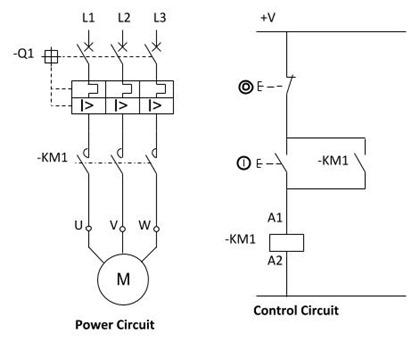Motor Starting - Direct On Line
In the first article of this series, we looked at why motor starting is important and some of the issues which need to be considered in selecting the correct starting method. Primarily these are transient events during starting and are concerned with voltage drops and accelerating the mechanical load. If you haven't read this article, it may be worth while doing so now (Motor Starting - Introduction).
Direct on line starting (DOL) is the simplest and most cost effective method of starting a motor. As the name suggests, in DOL starting the motor is simply connected to the electrical supply and accelerates according to it's inherent electrical and mechanical characteristics.
I prefer DOL starting and have used it on some very large motors (well into the MW range). If the power supply can provide the necessary starting currents, voltage drops are not detrimental and the mechanical load is not adversely affected by the high starting torque and acceleration then I would always employ DOL. There is just less to go wrong compared to other starting methods.
Power and Control Circuiting
This figures illustrate the power and control circuiting associated with DOL starting. As can be seen from the power circuit, closing the switching device (-Q1) connects to motor directly to the electrical supply via a contactor (-KM1).
Also illustrated in the diagram are the short circuit and magnetic/thermal overload protective functions.
The control circuit illustrates simple push button control for starting and stopping the motor. When the start button is pressed, power flows through -KM1 which will close the contactor and start the motor.
Push buttons used in motor control are typically 'momentary' (i.e. when pressed they will make or break the circuit and then when released revert to their normal state). Due to this a bypass auxiliary contact of -KM1 is used to maintain power and keep the switching device closed when the start button is released.
Pressing the stop button breaks the power to the circuit, opening the contactor by removing power from -KM1 and opening the bypass auxiliary contact.
While this power/control combination is probably the most basic arrangement for DOL starting, it is the foundation for developing more complex control requirements (i.e. PLC control, local/remote operation, etc.).
Motor Starting - Direct On Line Characteristics
Available starting current: 100%
Peak starting current: 4 to 8 In
Peak starting torque: 100%
|
Advantages |
Disadvantages |
|---|---|
| Simple Low Cost High Starting Torque |
High Starting Current High Starting Torque Mechanically Harsh |
That’s it for direct on line starting. The next article will be on star-delta starting which is somewhat more complex and has a few interesting side effects.
